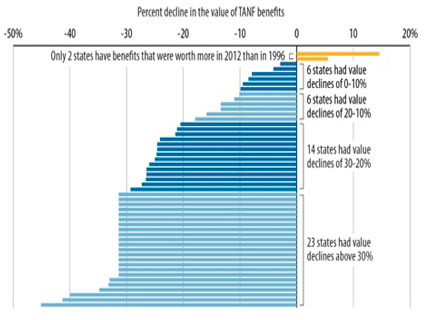The economy is picking up in some parts of the country, but that hasn’t translated into any new serious efforts to help those suffering the most hardship. In fact, for those on the lowest rung of the economic ladder, life may be getting even harder. A new report from the Center on Budget and Policy Priorities (CBPP) looks at cash benefits provided under the Temporary Assistance for Needy Families (TANF) program, commonly known as “welfare.” It finds that the value of monthly cash benefits that make up the fragile safety net for the poorest families with children has continued to decline steadily since the program was “reformed” in 1996.
Back then, benefits weren’t exactly generous, but they did manage to keep a whole lot of kids out of really deep poverty. Today, those benefits are almost nonexistent. The lucky few who are able to get cash assistance aren’t getting enough to pay rent or keep the lights on in most states, and the value of the benefits has declined precipitously since 1996—even more so since the recession started. According to CBPP, there is not a state in the country whose welfare benefits are enough to lift a poor single mother with two kids above 50 percent of the poverty line, or about $9700 a year. In many southern states, TANF doesn’t provide enough money to get a poor family much above 10 percent of the poverty line. What’s especially troubling about these figures is that, as CBPP reports, TANF benefits are often the only form of cash assistance poor families receive. They may be getting food stamps, which definitely help their situations, but you can’t buy diapers or pay the rent with food stamps.

People like President Bill Clinton and then-Speaker of the House Newt Gingrich claimed they’d be doing welfare recipients a favor in the 1990s when they reformed the welfare program to impose work requirements and make it more difficult for people to get benefits. The idea was that welfare recipients were just lazy and that their government checks were keeping them from working, making them dependent on the government. When the reform legislation passed, with Clinton’s signature, some people in the administration quit in protest, arguing that cutting off cash assistance for poor families would push millions of children into poverty. That didn’t happen, at least not right away. But funding for the TANF block grant hasn’t increased since 1996, meaning that in real terms, what the country spends to help poor families in the program has fallen 30 percent overall since welfare was “reformed,” and benefit levels have fallen even more in some states that cut benefits after the financial crisis started in 2007. Not surprisingly, since 1996, the number of families with children living in extreme poverty—that is, on $2 a day or less—has gone up nearly 130 percent.
The US Census Bureau reports that the number of Americans suffering significant hardships, such as having utilities cut off, getting evicted, or suffering food shortages, has escalated sharply during the recession. Between 2005 and 2011, nearly 7 million additional people were unable to make a mortgage or rent payment, suggesting that as the nation’s last-ditch safety net for people in really dire straits, TANF, is not working. Given that science is now showing just how damaging the stress of poverty is to children and their health and intellectual development, maybe it’s finally time for welfare reform to be reformed in a way that gives poor kids a fair shot at a decent future.









